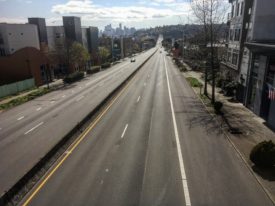Green industries grow jobs and labor income faster than environmentally high-impact industries. Perhaps we already knew that, but I just discovered an economic model that demonstrates how shifting Washington’s industrial output to green collar jobs will benefit workers’ pocketbooks.
For example, the model can compare educational services to petroleum products. And it shows that increasing sales in education, rather than the petroleum, will create 12 times as many jobs and 20 times more labor income.
These numbers don’t come from a crystal ball. They’re based on an Input-Output Impact Model, which is used by government agencies and private consultants to estimate the economic impacts of a project or a budget. The model tries to tabulate how industries stimulate one another by tracking how much they sell to consumers as compared to other local industries. It can be used to see the overall economic ramifications of boosting one industry versus another. In the example above, it tells us that educational services create a lot more local economic activity than petroleum products.
I took advantage of the Washington State Input Output Model on the Office of Finance and Management’s website. OFM generously provides a worksheet in which anyone can play Mao and redistribute industrial growth or boost output in certain industries by plugging in numbers on a spreadsheet.
For example, let’s say we model a decrease of $5 million in output from a few high-impact industries such as: “Animal Production,” “Logging,” “Mining,” and “Petroleum Products” and move that $5 million into “Food Services and Drinking Places,” “Arts, Recreation and Accommodation,” “Health Services,” and “Educational Services.” The worksheet tells us that total economic output will increase by $3 million; 435 new jobs will be created; and labor income will increase by $6.3 million. Not too shabby!
Of course the service industry cannot fuel our entire economy. So let’s try some green shifting within the sectors that produce physical things.
This time let’s take $7 million each from “Chemical Manufacturing,” “Food Manufacturing,” and “Fabricated Metals” and let’s move it to “Computer and Electronic Products,” “Crops,” and “Textiles and Apparel.” With this shift we actually lost total output on the order of $2.8 million. But we gained elsewhere: 141 new jobs and around $1 million in labor income, a net for Washington workers and the environment.
Try it for yourself (xls). You can grow and shrink various economic sectors (table 1 column B) and see the results for gross output, the number of jobs, and labor income (table 5 Columns B, C, D on row 265).
Here’s a look at the best and worst industries for overall job creation if they received an independent $5 million output boost.
The best:
|
Industry |
New Jobs |
Labor Income Increase (millions) |
|
Educational services |
213 |
$4.6 |
|
Food services and drinking places |
203 |
$3.6 |
|
Other services |
196 |
$4.3 |
|
Arts, recreation, and accommodation |
187 |
$4.1 |
|
Health services |
164 |
$4.8 |
The worst:
|
Industry |
New Jobs |
Labor Income Increase (millions) |
|
Petroleum and products |
11 |
$0.4 |
|
Gas utilities |
32 |
$1.3 |
|
Aircraft and parts |
49 |
$2.0 |
|
Electric utilities |
55 |
$2.2 |
|
Primary metals |
56 |
$2.0 |
OFM’s model is useful for only small-scale change and it makes some assumptions and extrapolations that stretch certainty. Still, it appears that shifting the economy toward greener jobs will also move us toward a healthier economy—one with fatter paychecks and more job opportunities. Because this model does not account for production limitations, such as the depletion of natural resources—a limitation that plagues too many economic models—the real economy would likely favor green industries even m
ore.
One more note of caution, however: if we don’t change our consumption habits, a green shift in our local economic output will simply send the environmentally high-impact industries elsewhere. So to be meaningful, a shift to green collar jobs shift must go hand-in-hand with a shift to greener buying habits.








a-kos
Deric makes some relevant, practical suggestions, but I’m still realistic/skeptical that there will be significant improvement for one reason: our society encourages rampant consumption as one of the primary catalysts of sustain and maintain our economy.Adverstising and marketing are arguably the most powerful forces in the US and most other modern industrial societies (I don’t know how anyone can dispute this). The primary basis for mondern economies is encourging consumers to spend (ie consume) as much as possible.There is a positive correlation between resources consumed/waste created, and socioeconomic acheivement. This correlation transcends politics. For instance a reputedly environmentally friendly city consumes about the same resources per capita as Houston.While it’s evident that shifting economic growth from resource/energy intensive industries like petroleum will make a significant difference, the seemingly unresolvable quandary remains: How do we simultaneously preserve/improve the environment when economic growth and sustainenance is based largely in encouraging as much consumption as possible?I’ve been reviewing and considering different perspectives on this problem for the past few years, and there appears to be no compelling, plausible solution. In order to resolve or even significantly alleviate this problem, we need to tranform our economy from one that is based on consumption, to one that is based on conservation/preservation. I for one don’t know of a way plausible to accomplishing this.
ejohnson
One other thing to consider: our entire economic/social system is based on human greed (not just the US, either) – one reason why it’s so hard to change the system is that you have to change that basic human characteristic to do it. Instilling a value system that contains the “I’ve got enough and don’t need more” into a populus may be impossible, though I wish someone would come up with a way to try it. It may need to start being instilled from the day of birth.Eric Johnson
a-kos
EJ,Unfortunately, I think you’re probably right. I’m reading a book: “A Language Older Than Words” by Derrick Jensen. Among the many topics, he discusses hunter/gather societies, many of which are almost entirely peaceful and spartan, showing no interest in the western concept of material wealth. This shows that it’s at least plausible for societies to thrive using a cooperative model, rather than one based on market/consumption.However it’s unrealstic to think a signficant portion of our western-socialized populace will ever reject consumerism (Jensen is one of the few exceptions), especially since the wealthiest, most powerful individual have in our society only benefit from maintaining and expanding this model. I must admit I feel almost paralyzed with helplessness when I even try to think of even vague concepts to undermine consumerism.